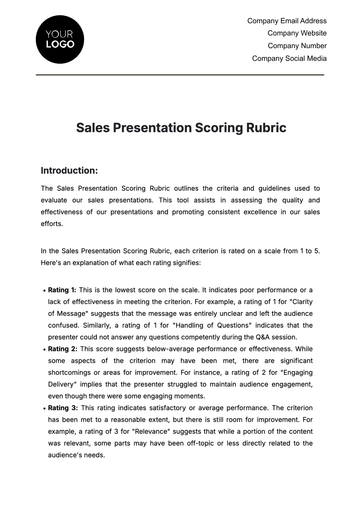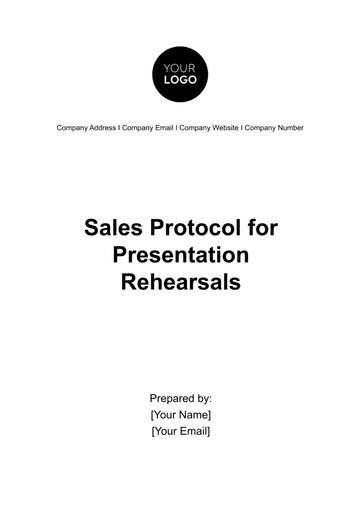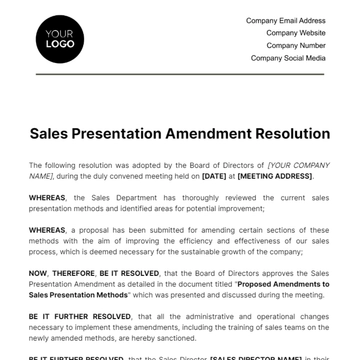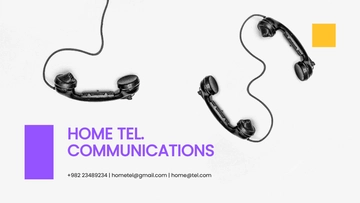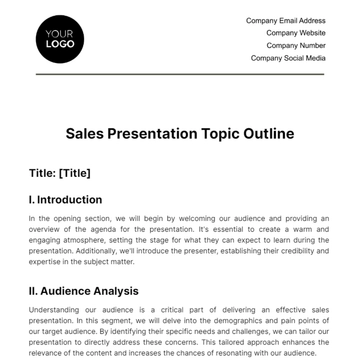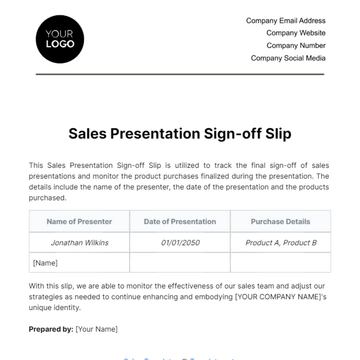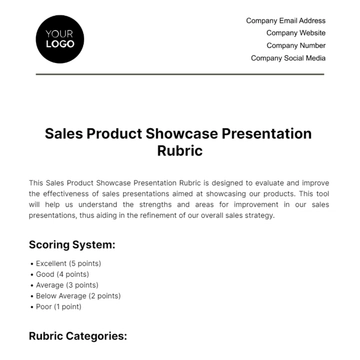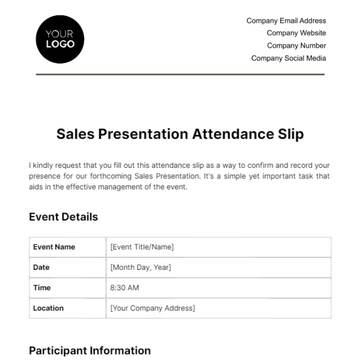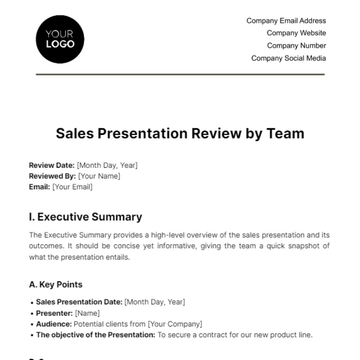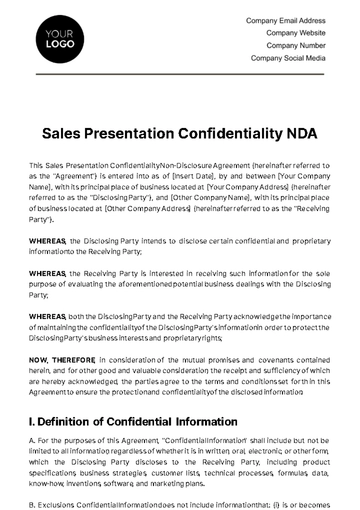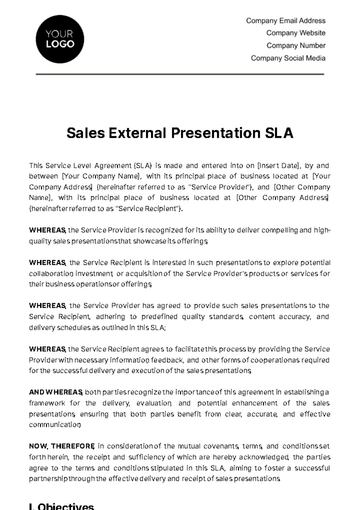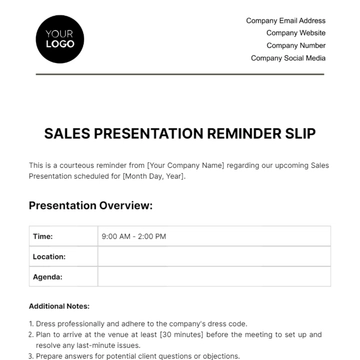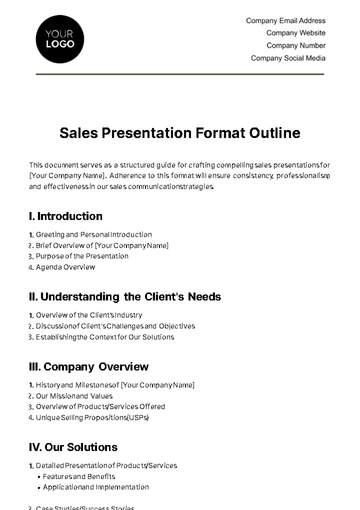Free Sales Presentation Scoring Rubric

Introduction:
The Sales Presentation Scoring Rubric outlines the criteria and guidelines used to evaluate our sales presentations. This tool assists in assessing the quality and effectiveness of our presentations and promoting consistent excellence in our sales efforts.
In the Sales Presentation Scoring Rubric, each criterion is rated on a scale from 1 to 5. Here's an explanation of what each rating signifies:
Rating 1: This is the lowest score on the scale. It indicates poor performance or a lack of effectiveness in meeting the criterion. For example, a rating of 1 for "Clarity of Message" suggests that the message was entirely unclear and left the audience confused. Similarly, a rating of 1 for "Handling of Questions" indicates that the presenter could not answer any questions competently during the Q&A session.
Rating 2: This score suggests below-average performance or effectiveness. While some aspects of the criterion may have been met, there are significant shortcomings or areas for improvement. For instance, a rating of 2 for "Engaging Delivery" implies that the presenter struggled to maintain audience engagement, even though there were some engaging moments.
Rating 3: This rating indicates satisfactory or average performance. The criterion has been met to a reasonable extent, but there is still room for improvement. For example, a rating of 3 for "Relevance" suggests that while a portion of the content was relevant, some parts may have been off-topic or less directly related to the audience's needs.
Rating 4: This score represents above-average performance or effectiveness. The criterion has been met well, with only minor areas for improvement. For instance, a rating of 4 for "Use of Visuals" indicates that visual aids mostly supported the message, although there were some inconsistencies.
Rating 5: This is the highest score on the scale, indicating outstanding performance or effectiveness. The criterion has been met exceptionally well, with no significant areas for improvement. For example, a rating of 5 for "Handling of Questions" suggests that the presenter effectively and confidently addressed all questions during the Q&A session.
These ratings provide a clear and structured way to evaluate various aspects of the sales presentation, helping to identify strengths and areas for development.
Section 1: Presentation Content
1. Clarity of Message (1-5)
Rating(1-5) | |
|---|---|
5 | The message was crystal clear and easy to understand. |
The message was mostly clear, but a few parts were confusing. | |
The message had moments of clarity but needed further simplification. | |
The message was often unclear and challenging to follow. | |
The message was entirely unclear and left the audience confused. |
Example: A presentation that scores a 4 in this category might have sections where the explanation of complex concepts could be simplified for better clarity.
2. Relevance (1-5)
Rating (1-5) | |
|---|---|
5 | The content was entirely relevant and addressed the audience's needs. |
Most of the content was relevant, with a few minor deviations. | |
The content had significant deviations but still contained relevant information. | |
A portion of the content was relevant, but most was off-topic. | |
The content was entirely irrelevant to the audience's needs. |
Example: A presentation that scores a 3 in this category may have some sections that are not directly related to the audience's concerns but still contain valuable information.
Section 2: Presentation Delivery
3. Engaging Delivery (1-5)
Rating (1-5) | |
|---|---|
5 | The presenter captivated the audience with a dynamic and engaging delivery. |
The presenter was engaging, but there were moments of monotony. | |
The presentation was generally engaging, but the delivery lacked consistency. | |
The presenter struggled to maintain audience engagement. | |
The presentation was entirely unengaging, leading to audience disinterest. |
Example: A presentation that scores a 4 in this category might have moments where the presenter's tone and energy level fluctuate, affecting engagement.
4. Use of Visuals (1-5)
Rating (1-5) | |
|---|---|
5 | Visual aids were highly effective, enhancing the message. |
Visual aids mostly supported the message, but there were some inconsistencies. | |
Visual aids were used but did not consistently enhance the message. | |
Visual aids were present but detracted from the presentation. | |
Visual aids were entirely ineffective and confused the audience. |
Example: A presentation that scores a 2 in this category may include visuals that were distracting or not aligned with the message.
Section 3: Q&A Session (1-5)
5. Handling of Questions (1-5)
Rating (1-5) | |
|---|---|
5 | The presenter effectively and confidently addressed all questions. |
Most questions were answered well, but a few required more research. | |
The presenter answered some questions but struggled with others. | |
Many questions went unanswered, and the presenter appeared unprepared. | |
The presenter could not answer any questions competently. |
Example: A presentation that scores a 3 in this category may have moments where the presenter handled some questions confidently but struggled with more complex inquiries.
Conclusion:
The Sales Presentation Scoring Rubric serves as a valuable tool for evaluating the effectiveness of our sales presentations. The provided examples illustrate different scoring scenarios within each category, offering clear guidelines for presentation assessment. By consistently using this rubric, we can refine our presentation skills and elevate our sales efforts.
Prepared By:
[Your Name]
[Your Email]
[Your Company Name]
[Your Company Email]
[Your Company Address]
[Your Company Number]
[Your Company Website]
[Your Company Social Media]
- 100% Customizable, free editor
- Access 1 Million+ Templates, photo’s & graphics
- Download or share as a template
- Click and replace photos, graphics, text, backgrounds
- Resize, crop, AI write & more
- Access advanced editor
Elevate your pitch game with precision using this editable template. This customizable Sales Presentation Scoring Rubric Template provides a structured, objective framework for evaluating sales presentations with help from our AI editor tool. Seamlessly assess content, delivery, and overall impact, ensuring consistent, data-driven feedback. Revolutionize your presentations and drive conversions. So get it now at Template.net!
You may also like
- Aesthetic Presentation
- Presentation Background
- Slide Show Presentation
- Cute Presentation
- Education Presentation
- Border Frames Presentation
- Teacher Presentation
- Professional Presentation
- Timeline Presentation
- Brand Presentation
- Promotion Presentation
- Business Presentation
- Event Presentation
- Company Presentation
- Startup Presentation
- University Presentation
- Food Presentation
- Music Presentation
- School Presentation
- Art Presentation
- Marketing Presentation
- Business Plan Presentation
- Mobile Presentations
- Freelancer Presentation
- Project Presentation
- Agency Presentation
- Sales Presentation
- HR Presentation
- Product Presentation
- Roadmap Presentation
- Slideshow
- Technology Presentation
- Real Estate Presentation
- Medical Presentation
- Speaker Presentation
- Construction Presentation
- Conference Presentation
- Restaurant Presentation
- IT and Software Presentation
- Portfolio Presentation
- Campaign Presentation
- Game Presentation
- History Presentation
- Math Presentation
- Lesson Presentation
- Health Presentation
- Graduation Presentation
- New Year's Day Presentation
- Social Studies Presentation
- Photography Presentation
- Social Media Presentation
- Valentine's Day Presentation
- Services Presentation
- Workshop Presentation
- Organization Presentation


